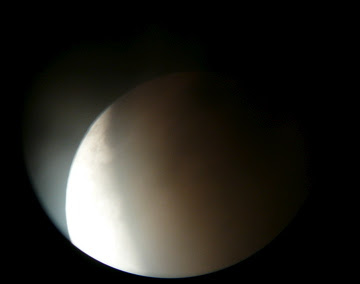Earlier this year in February, there was a lunar eclipse so I thought I would bust out the family telescope while there was good seeing. (That's astronomy terms for "a good night to view the sky when there is no wind, cosmic dust or such in the way.")

A total lunar eclipse happens when the moon passes through Earth's shadow. It will appear as though the Earth's shadow is "eating" the moon.

The redness is caused by sunlight being refracted off Earth's atmosphere and onto the moon. The next total lunar eclipse will not happen until 2010 and the next total solar eclipse will not happen until 2017! Since I had the telescope out I thought I would check out Saturn.

The little dot to the left of the moon is Saturn. Saturn is mostly made up of gases, 98% helium and hydrogen. At the core, the pressure is so intense that it turns the gaseous hydrogen into liquid metallic hydrogen! Woah! Saturn is like Jupiter in that it has many storms and high winds created from the rising heat off the planet. Through the telescope you can see the rings, some strips on the planet and a couple of it's six medium sized moons. Saturn's rings were discovered in 1610 by Galileo. They stretch a whopping 100,000 miles across, but are only a 100ft thick! The rings are mostly made of frozen chunks of ice, talk about a slushy! There are several moons that are considered "shepherd moons" because their gravity influences the shape of the rings.

Of course my little camera won't pick that stuff out. In fact it didn't even want to focus on the planet as you can tell. I still enjoyed looking at it though!
 A total lunar eclipse happens when the moon passes through Earth's shadow. It will appear as though the Earth's shadow is "eating" the moon.
A total lunar eclipse happens when the moon passes through Earth's shadow. It will appear as though the Earth's shadow is "eating" the moon.  The redness is caused by sunlight being refracted off Earth's atmosphere and onto the moon. The next total lunar eclipse will not happen until 2010 and the next total solar eclipse will not happen until 2017! Since I had the telescope out I thought I would check out Saturn.
The redness is caused by sunlight being refracted off Earth's atmosphere and onto the moon. The next total lunar eclipse will not happen until 2010 and the next total solar eclipse will not happen until 2017! Since I had the telescope out I thought I would check out Saturn.  The little dot to the left of the moon is Saturn. Saturn is mostly made up of gases, 98% helium and hydrogen. At the core, the pressure is so intense that it turns the gaseous hydrogen into liquid metallic hydrogen! Woah! Saturn is like Jupiter in that it has many storms and high winds created from the rising heat off the planet. Through the telescope you can see the rings, some strips on the planet and a couple of it's six medium sized moons. Saturn's rings were discovered in 1610 by Galileo. They stretch a whopping 100,000 miles across, but are only a 100ft thick! The rings are mostly made of frozen chunks of ice, talk about a slushy! There are several moons that are considered "shepherd moons" because their gravity influences the shape of the rings.
The little dot to the left of the moon is Saturn. Saturn is mostly made up of gases, 98% helium and hydrogen. At the core, the pressure is so intense that it turns the gaseous hydrogen into liquid metallic hydrogen! Woah! Saturn is like Jupiter in that it has many storms and high winds created from the rising heat off the planet. Through the telescope you can see the rings, some strips on the planet and a couple of it's six medium sized moons. Saturn's rings were discovered in 1610 by Galileo. They stretch a whopping 100,000 miles across, but are only a 100ft thick! The rings are mostly made of frozen chunks of ice, talk about a slushy! There are several moons that are considered "shepherd moons" because their gravity influences the shape of the rings.  Of course my little camera won't pick that stuff out. In fact it didn't even want to focus on the planet as you can tell. I still enjoyed looking at it though!
Of course my little camera won't pick that stuff out. In fact it didn't even want to focus on the planet as you can tell. I still enjoyed looking at it though!